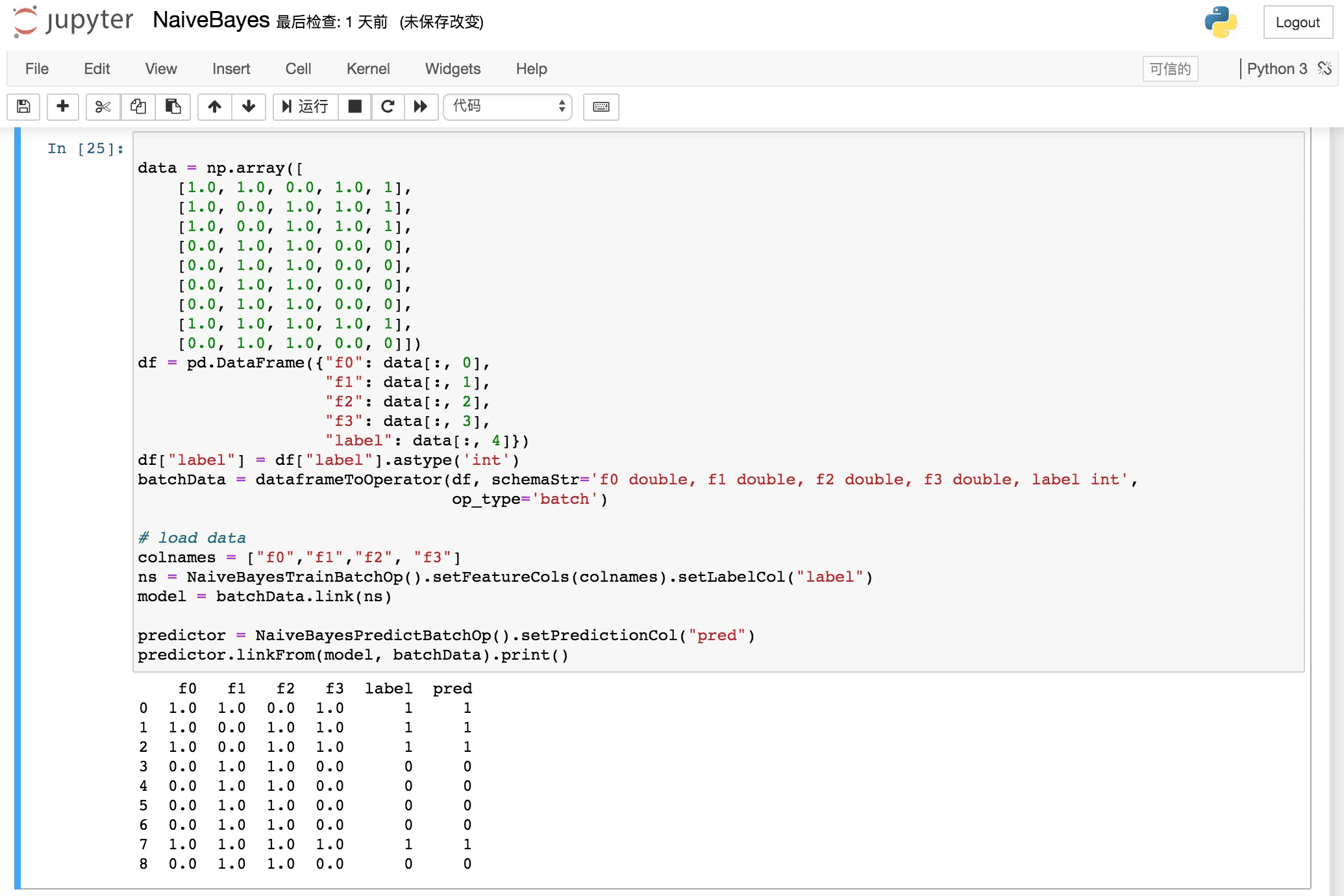English| 简体中文
Alink is the Machine Learning algorithm platform based on Flink, developed by the PAI team of Alibaba computing platform. Welcome everyone to join the Alink open source user group to communicate.
- PyAlink provides different Python packages for Flink versions that Alink supports:
package
pyalinkalways maintains Alink Python API against the latest Flink version, which is 1.13, whilepyalink-flink-***support old-version Flink, which arepyalink-flink-1.12,pyalink-flink-1.11,pyalink-flink-1.10andpyalink-flink-1.9for now. - The version of python packages always follows Alink Java version, like
1.6.2.
- Make sure the version of python3 on your computer is 3.6, 3.7 or 3.8.
- Make sure Java 8 is installed on your computer.
- Use pip to install:
pip install pyalink,pip install pyalink-flink-1.12,pip install pyalink-flink-1.11,pip install pyalink-flink-1.10orpip install pyalink-flink-1.9.
-
pyalinkand/orpyalink-flink-***can not be installed at the same time. Multiple versions are not allowed. Ifpyalinkorpyalink-flink-***was/were installed, please usepip uninstall pyalinkorpip uninstall pyalink-flink-***to remove them. -
If
pip installis slow of failed, refer to this article to change the pip source, or use the following download links: -
If multiple version of Python exist, you may need to use a special version of
pip, likepip3; If Anaconda is used, the command should be run in Anaconda prompt.
After PyAlink installed, you can run download_pyalink_dep_jars to download dependency jars for file system and Hive.
(If there is an error that could not find the command, you can run the python command python3 -c 'from pyalink.alink.download_pyalink_dep_jars import main;main()' directly.)
After executed the command, you'll see a prompt asking you about the dependencies and their versions to be downloaded. The following dependencies and their versions of jars are supported:
- OSS:3.4.1
- Hadoop:2.8.3
- Hive:2.3.4
- MySQL: 5.1.27
- Derby: 10.6.1.0
- SQLite: 3.19.3
- S3-hadoop: 1.11.788
- S3-presto: 1.11.788
- odps: 0.36.4-public
These jars will be installed to the lib/plugins folder of PyAlink.
Note that these command require the access for the folder.
You can also add the argument -d when executing the command, i.e. download_pyalink_dep_jars -d.
It will install all dependency jars.
You can start using PyAlink with Jupyter Notebook to provide a better experience.
Steps for usage:
-
Start Jupyter:
jupyter notebookin terminal , and create Python 3 notebook. -
Import the pyalink package:
from pyalink.alink import *. -
Use this command to create a local runtime environment:
useLocalEnv(parallism, flinkHome=None, config=None).Among them, the parameter
parallismindicates the degree of parallelism used for execution;flinkHomeis the full path of flink, and usually no need to set;configis the configuration parameter accepted by Flink. After running, the following output appears, indicating that the initialization of the running environment is successful.
JVM listening on ***
Python listening on ***
- Start writing PyAlink code, for example:
source = CsvSourceBatchOp()\
.setSchemaStr("sepal_length double, sepal_width double, petal_length double, petal_width double, category string")\
.setFilePath("https://alink-release.oss-cn-beijing.aliyuncs.com/data-files/iris.csv")
res = source.select(["sepal_length", "sepal_width"])
df = res.collectToDataframe()
print(df)In PyAlink, the interface provided by the algorithm component is basically the same as the Java APIs, that is, an algorithm component is created through the default construction method, then the parameters are set through setXXX, and other components are connected through link / linkTo / linkFrom.
Here, Jupyter Notebook's auto-completion mechanism can be used to provide writing convenience.
For batch jobs, you can trigger execution through methods such as print / collectToDataframe / collectToDataframes of batch components or BatchOperator.execute (); for streaming jobs, start the job with StreamOperator.execute ().
- Interchange between DataFrame and Operator
- StreamOperator data preview
- UDF/UDTF/SQL usage
- Use with PyFlink
- PyAlink Q&A
String URL = "https://alink-release.oss-cn-beijing.aliyuncs.com/data-files/iris.csv";
String SCHEMA_STR = "sepal_length double, sepal_width double, petal_length double, petal_width double, category string";
BatchOperator data = new CsvSourceBatchOp()
.setFilePath(URL)
.setSchemaStr(SCHEMA_STR);
VectorAssembler va = new VectorAssembler()
.setSelectedCols(new String[]{"sepal_length", "sepal_width", "petal_length", "petal_width"})
.setOutputCol("features");
KMeans kMeans = new KMeans().setVectorCol("features").setK(3)
.setPredictionCol("prediction_result")
.setPredictionDetailCol("prediction_detail")
.setReservedCols("category")
.setMaxIter(100);
Pipeline pipeline = new Pipeline().add(va).add(kMeans);
pipeline.fit(data).transform(data).print();<dependency>
<groupId>com.alibaba.alink</groupId>
<artifactId>alink_core_flink-1.13_2.11</artifactId>
<version>1.6.2</version>
</dependency>
<dependency>
<groupId>org.apache.flink</groupId>
<artifactId>flink-streaming-scala_2.11</artifactId>
<version>1.13.0</version>
</dependency>
<dependency>
<groupId>org.apache.flink</groupId>
<artifactId>flink-table-planner_2.11</artifactId>
<version>1.13.0</version>
</dependency>
<dependency>
<groupId>org.apache.flink</groupId>
<artifactId>flink-clients_2.11</artifactId>
<version>1.13.0</version>
</dependency><dependency>
<groupId>com.alibaba.alink</groupId>
<artifactId>alink_core_flink-1.12_2.11</artifactId>
<version>1.6.2</version>
</dependency>
<dependency>
<groupId>org.apache.flink</groupId>
<artifactId>flink-streaming-scala_2.11</artifactId>
<version>1.12.1</version>
</dependency>
<dependency>
<groupId>org.apache.flink</groupId>
<artifactId>flink-table-planner_2.11</artifactId>
<version>1.12.1</version>
</dependency>
<dependency>
<groupId>org.apache.flink</groupId>
<artifactId>flink-clients_2.11</artifactId>
<version>1.12.1</version>
</dependency><dependency>
<groupId>com.alibaba.alink</groupId>
<artifactId>alink_core_flink-1.11_2.11</artifactId>
<version>1.6.2</version>
</dependency>
<dependency>
<groupId>org.apache.flink</groupId>
<artifactId>flink-streaming-scala_2.11</artifactId>
<version>1.11.0</version>
</dependency>
<dependency>
<groupId>org.apache.flink</groupId>
<artifactId>flink-table-planner_2.11</artifactId>
<version>1.11.0</version>
</dependency>
<dependency>
<groupId>org.apache.flink</groupId>
<artifactId>flink-clients_2.11</artifactId>
<version>1.11.0</version>
</dependency><dependency>
<groupId>com.alibaba.alink</groupId>
<artifactId>alink_core_flink-1.10_2.11</artifactId>
<version>1.6.2</version>
</dependency>
<dependency>
<groupId>org.apache.flink</groupId>
<artifactId>flink-streaming-scala_2.11</artifactId>
<version>1.10.0</version>
</dependency>
<dependency>
<groupId>org.apache.flink</groupId>
<artifactId>flink-table-planner_2.11</artifactId>
<version>1.10.0</version>
</dependency><dependency>
<groupId>com.alibaba.alink</groupId>
<artifactId>alink_core_flink-1.9_2.11</artifactId>
<version>1.6.2</version>
</dependency>
<dependency>
<groupId>org.apache.flink</groupId>
<artifactId>flink-streaming-scala_2.11</artifactId>
<version>1.9.0</version>
</dependency>
<dependency>
<groupId>org.apache.flink</groupId>
<artifactId>flink-table-planner_2.11</artifactId>
<version>1.9.0</version>
</dependency>- Prepare a Flink Cluster:
wget https://archive.apache.org/dist/flink/flink-1.13.0/flink-1.13.0-bin-scala_2.11.tgz
tar -xf flink-1.13.0-bin-scala_2.11.tgz && cd flink-1.13.0
./bin/start-cluster.sh- Build Alink jar from the source:
git clone https://github.com/alibaba/Alink.git
# add <scope>provided</scope> in pom.xml of alink_examples.
cd Alink && mvn -Dmaven.test.skip=true clean package shade:shade- Run Java examples:
./bin/flink run -p 1 -c com.alibaba.alink.ALSExample [path_to_Alink]/examples/target/alink_examples-1.5-SNAPSHOT.jar
# ./bin/flink run -p 1 -c com.alibaba.alink.GBDTExample [path_to_Alink]/examples/target/alink_examples-1.5-SNAPSHOT.jar
# ./bin/flink run -p 1 -c com.alibaba.alink.KMeansExample [path_to_Alink]/examples/target/alink_examples-1.5-SNAPSHOT.jar

